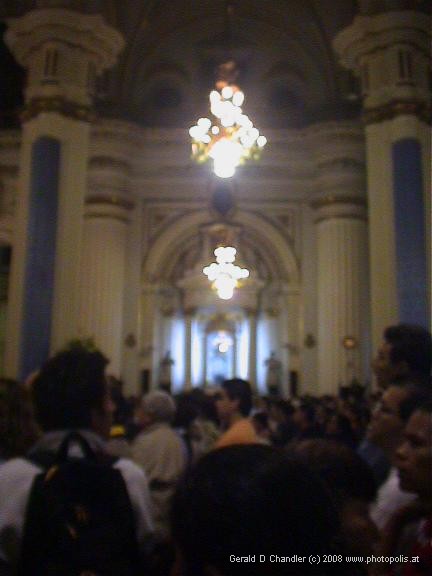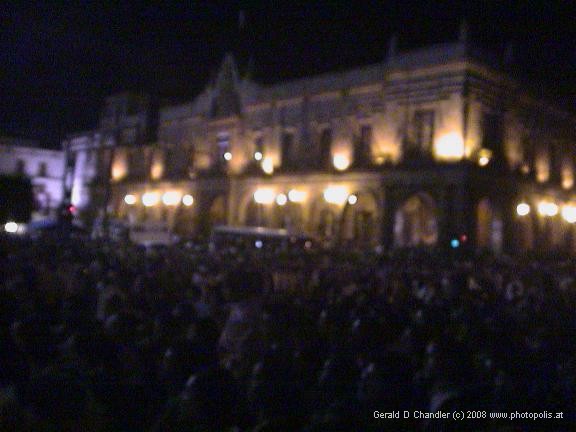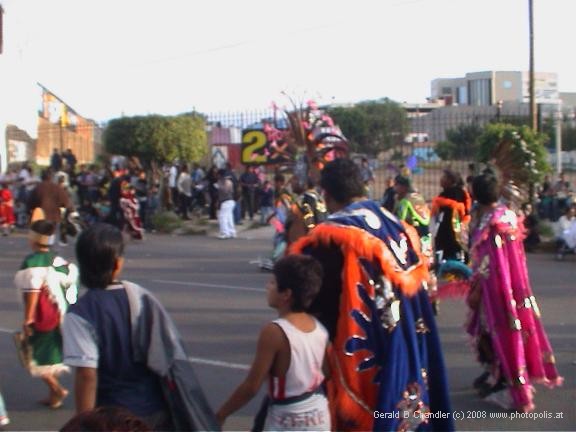Home | Front Page | Blog | Index | New | Contact | Site Map
Lake Chapala
Guadalajara
Virgen de Zapopan
NuevoLeon
Coahuila
Chihuahua
Sonora
Durango
Jalisco
Sinaloa
Zacatecas
San Luis Potosi
Queretaro
Guanajuato
Michoacan
Guerrero
Morelos
Puebla
Tlaxcala
Oaxaca
Chiapas
Campeche
Yucatan
Quintana Roo
Teotenango
Xochicalco
Monte Alban
Mitla
Palenque
Uxmal
Chichen Itza
Tolum
Belize Mayans
Tikal
Copan
General Topics
Churches
Beach Bumming
Swimming Along
States
Websites
Map
Car Costs
> USA-Britain
USA 2003
USA 2002
Britain 2002
The Virgin of Zapopan is a statue of the Virgin Mary that has a permanent home in the main church of Zapopan, a small town 5 miles from Guadalajara, Mexico's second largest city. . The statue is very small — about the size of a Barbie Doll and dressed in rich brocade robes. Nowadays it is kept in a keyhole-shaped transparent (glass or plastic) container, although it probably wasn't always. We don't know if the actual statue is as old as the celebration in its honor, but the tradition, called the Romeria in Spanish, began, according to our sources, in 1606. In that year, the church of Zapopan was destroyed by an earthquake but by chance, or a miracle depending on your point of view, the small statue of the Virgin survived. To celebrate the miracle and while waiting for the church to be rebuilt, the statue was sent in turn to each of the 180 or so churches in the archdiocese of Guadalajara before being returned home to Zapopan. Immediately before being returned to Zapopan, the Virgin resides for one month in the Cathedral of Guadalajara, the seat of the Archdiocese. The current Archbishop of Guadalajara is also a Cardinal, by the way, so Guadalajara is an important city for the Catholic Church in Mexico. Indeed, the first Mexican Cardinal was also an Archbishop of Guadalajara.

Guadalajara Cathedral at 5am |
We had been hearing about the Romeria for a couple of weeks and were determined to see what it was all about. The celebration lasts two full days, October 11th and 12th. Around 9 p.m. on the evening of the 11th, we went out to see what celebrations were going on. We had been told that people stay up all night partying so that they can accompany the statue on its way home. We certainly found lots of entertainment going on. Almost every public square in the center of town had some stage set up with music and (as we were told) dancing to entertain the crowds. The interesting thing for us was to compare the entertainment here that had a clear religious bent to that put on in Durango for the Fiestas Patrias, or National Festivities, that were of course of a nationalistic flavor.
We sat and listended to the music for a while, then walked over to the Cathedral and with hundreds of other people waited patiently in front of one of the three front entrances for the privilege of walking through the cathedral, past the statue of the Virgin and out the side door. It reminded us a lot of visiting the Sacre Coeur in Paris. We stopped inside and stood around for a while listening to the mass but eventually we were ushered on our way to make way for the people still waiting outside. The early comers of course had found seats for themselves and must have sat there a good three or four hours . alreadyAfter leaving the Cathedral, we walked around from square to square for about an hour and a half stopping at one point to talk to a group of policeman to ask them if people really would stay up all night. They were very friendly and answered us in English and assured us that not only other people, but they too would be up all night, and that everything would be very safe. We thanked them and walked on back towards the Cathedral. Shortly before we got back we saw and heard fireworks going off and stepped up our pace to catch the last half. And then we made our way back to the hotel for a foreshortened night’s sleep.

Guadalajara Crowds Celebrating the Romeria |
Gerry had set the alarm for 4 a.m. and that is when we woke up, slowly got up and dressed and were out of the hotel by about 4:20. We walked directly to the Cathedral and found the streets mostly empty but the square itself filled with people , eating, dozing, waiting. The entertainers were still going, but we bypassed them and instead went into the Cathedral which no longer had crowds at the door but still had every seat filled and lots of people sitting and even sleeping in the aisles, and spent about a half hour standing in the aisle listening to the mass that seemed to have been going on continuously since the previous evening.
At about 5:15 a.m.we heard the sounds of a marching band outside and decided to go out and investigate. As we emerged onto the front steps of the rightmost doors, we could see the car that was waiting to carry the statue back to Zapopan. It was the size of a small float, was decorated with flowers, and had a special high, gold-painted platform in the center that was surrounded by a lighted arch where the statue would be placed. There were lots of people milling around the car and lots of people gathering in the square facing the car and the Cathedral. We stood for a while on the steps with our back to the Cathedral watching the crowds gather and then sat down on the steps to wait for the appointed hour, which we had been told would be around six a.m.
The church service was still going on inside. It was still dark outside. Lots of people were still entering and leaving the church although as more and more people sat down on the steps the room for those coming and going shrunk to almost nothing. About ten minutes to six, activity started around the car, with the marching band lining up in front of the car (i.e. to its right from our point of view, which was the direction the parade would go) and playing now and again. The people who were to pull the car were gathering and being organized and steps were taken to ready the platform for its precious burden by removing screws here and there and so on.

Marchers in the Virgin's Parade |
By six the square was very full and we could see that the church behind us was full too. Jan heard the priest telling people that those in the side aisles should not move while the Virgin was carried from the church. She hoped that they would listen to the instruction because if they all tried to come out there would be nowhere for them to go. All the people seated on the steps were now standing and had been joined by others so that there was no space for anybody else. We of course were happy to be up on the steps as we could clearly see the carriage and the crowds around and beyond it. To Jan it looked a little chaotic, although everyone was very peaceful and friendly. There were a group of young people with yellow tunics on marked “Orden”, but they didn’t seem to have any kind of plan for crowd control in front of the Cathedral. Still, the event occurred every year, so she assumed they must have a good idea of what would happen and must think that nothing more was needed. There was only one small bit of trouble in our area when two women who were in the church forced their way out in spite of instructions and the objections of those of us on the steps. Some words were exchanged but in the end the women managed to get out it was fortunately an isolated incident.
Shortly after six, we heard things moving in the church and ultimately saw the statue emerge and be placed on the carriage and secured. The religious leaders lined up behind the carriage and in one or two minutes the order was given; the marching band struck up a tune and marched off; the carriage was pulled and off everybody went at quite a quick walking pace. Down the street to the left and behind the carriage we could see banners and presumed that there were one or two groups of people who would parade behind the carriage to Zapopan. As the parade started to move, the crowd slowly moved alongside them and gently carried us along too. Again there was a a sense of peaceful chaos, if such a thing can exist. There were no obvious monitors and the crowd just wandered happily on either side of the carriage, the pullers, and the marching band. The crowd in fact was going faster than the parade and so we thought perhaps we might do the same and find the head of the parade. We never did, but we did chat for a while with a 60-something woman from Guadalajara who had lived in L.A. and Arcadia, CA for a long time. And eventually, We caught up with a group of seminarians who might have been the head of the parade but we couldn’t get past them to be sure. They did have some parade crowd control and kept moving the accompanying crowd off to the side of the road.
After an hour of walking, listening to the seminarians chanting and praying, we noticed the first signs of dawn in the eastern sky. A half hour later still, we came to a McDonald’s and decided that this was as far as we would go and that it was time for breakfast. The McDonald’s was built up a bit so from its entranceway we could look back at the parade and so stood there waiting to see the statue one last time before going in for breakfast. We were surprised at the amount of parade that separated the seminarians where we had been walking from the statue on her carriage. At first we thought we had missed her, but after another ten minutes, there she came into view.

Indian Dancers Still on the Road to Zapopan after Sunrise |
After breakfast, we walked out expecting the parade to be over, but found that there was lots still going on and so we found a place on the sidewalk to watch it. Every conceivable organization had a group in the parade and they were all dressed up as Indians. Every group had some kind of drum or flute to accompany them and they all did a kind of Indian dance along the street. The unusual aspect of the dancing was that every dancer had some kind of metal plate attached to their shoes so that as they danced they made an enormous racket on the paved street. It reminded Jan very much of the noise of Chinese parades and celebrations, ear-splitting sometimes. The Mexicans weren’t quite as bad, but it was still pretty loud.
Eventually, of course, the parade did come to an end, and was followed by a very efficient cleanup campaign in which sweepers with brooms, swept empty cups and other debris from the sidewalks and gutters into the street then were followed by a man with a blower who worked mostly on the gutters and then finally big sweepers made up the rear leaving the road pretty clean and clear. Sadly, the sidewalks didn’t get such an effective treatment and so were pretty messy as we walked back into town and back to our hotel to take a nap. The papers the next day said that three million people took part in the parade, although we think that might include bystanders as well as participants. The weather by all accounts was perfect and the crowd continued their celebrations all day in Zapopan. No serious crimes or illnesses were reported and it was dubbed an unqualified success.
romería: feminine ecclesiastical: pilgrimage; gathering at a shrine; figuratively trip, excursion (Diccinario bilingüe Español/Inglés-English/Spanish Copyright C. Langenscheidt KG Berlin and Munich 2000.)
The photographs in this section of our website are sometimes out of focus because of low light conditions, but sometimes it is because Gerry's 3-year old SONY camera was undergoing a slow death. When faced with the choice of these photos or no photos we chose these photos.
